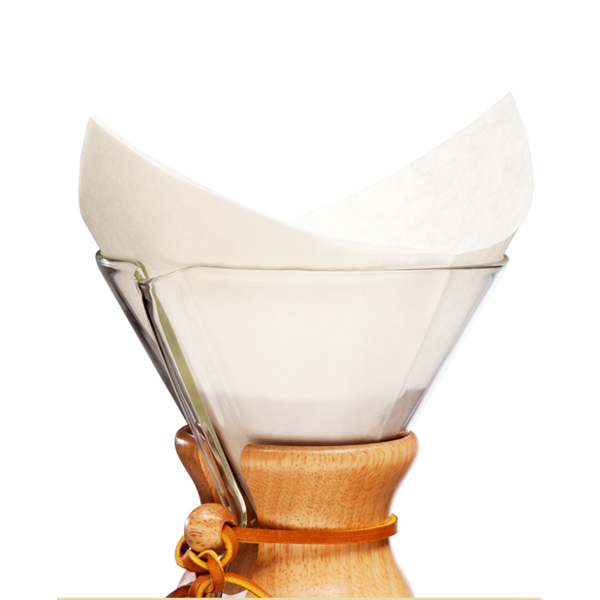By James Gallagher for Steampunk Coffee
Back when I started brewing with the Aeropress, I knew there was one method of filtering coffee: paper. I later learned that the French press used a metal filter, which added a new type of filtration to my repertoire. Later I learned about cloth filtration, a method of filtering which I had seen was used commonly in the Japanese "Nel drip" method of brewing.
Over the course of my home brewing journey, I have become familiar with all three of these types of filtration and I have a few thoughts I'd like to share about each of them. In this article, I'm going to briefly chat about paper, metal, and cloth filters for coffee and why you might want to use each of them. I will also chat briefly about using no filters when you are brewing coffee.
Paper Filters
Paper filters are incredibly common options for pour-over coffee-making devices and coffee brewing machines. In many cases, the manufacturer of a coffee brewing product will have official paper filters you can use with their products. For instance, Hario, who makes the V60 brewer, also makes filter papers for all three sizes of the V60. The Aeropress, to use another example, comes with a pack of filter papers, which you can also buy separately.
Paper filtration is effective at removing most of the coffee grounds that you might not want in your final cup of coffee. The result, depending on the type of filter paper you use, is what professionals and home enthusiasts call a "clean cup" of coffee. The difference between a clean cup and a muddy cup (a term derived from the colour of the brewed coffee) is how much sediment -- or pieces of coffee -- make their way into the final cup of coffee.
I prefer to use paper filters because they are convenient. If I want to make a cup of coffee with a paper filter, all I have to do is take the filter out of the packet and, depending on the brewing method, fold the filter paper in a certain way. That is more convenient than cloth filters, which I will discuss later. However, this convenience does come with some drawbacks: (i) you will throw away a paper filter every time you use one and; (ii) you will need to keep buying filter papers for your chosen method of brewing.
Metal Filters
Metal filters are most commonly associated with the French press. The French press is a container in which you brew coffee. After the coffee has brewed, you press a metal filter down to help hold back some of the larger grounds of coffee. This means that your final cup of coffee will not contain most of the big coffee grinds that you used to brew your coffee in the first place. You can also get metal filters for the Aeropress and some pour-over brewers use metal filtration.
Metal filters are known for producing a muddier cup of coffee in terms of colour because more coffee grounds tend to make their way into the brewed cup of coffee. This is because metal filters are not as effective at keeping very small pieces of coffee out of your cup. Because more of these small pieces make their way into your cup of coffee, you may feel that your coffee is gritty at times, especially towards the end. This grittiness is down to the small pieces of coffee that remain in your cup. To avoid them, you might want to hold back from trying to sip every last drop out of your cup.
Metal filters are a popular option for many. You do not need to keep buying paper filters if you use a metal filter. You will also end up with a fuller bodied cup of coffee, which is a flavour profile that lots of people enjoy. Some people claim more oils get through a metal filter than a paper filter which may contribute to the characteristic French press or metal filtered coffee profile.
Cloth Filters
Cloth filters are pieces of fabric that have been made in shapes to fit a particular brewer. These pieces of cloth are very effective at keeping out coffee grounds and are said to let some of the oils through from the coffee that would otherwise be filtered if you used a paper filter. Some people say that cloth filters are somewhere in the middle of paper and metal filters in that they keep grounds out like a paper filter but let some oils through like a metal filter.
I am a big fan of cloth filters because, when properly kept, they can produce a delicious cup of coffee. Some of the best cups of coffee I have made at home have been brewed using a cloth filter. I often find cloth filters have a heavier body than a paper filter can provide, which might be down to the oils. I like to think that cloth filters create an almost "buttery" texture that feels a bit thicker on the tongue.
Cloth filters do need maintenance but the amount of work you need to put in to maintain a cloth filter paper is manageable if you are serious about owning a cloth filter. All you need to do is thoroughly rinse your filter after each use and store it in a container filled with water. You should keep this container in the fridge at all times. This set up helps prevent against the growth of mildew and mould. You are also supposed to boil your filter paper in hot water every so often, but I will defer to the manufacturers of whichever filter you have to give more detailed instructions on proper care for your specific filter.
I will be honest and say that even after buying a cloth filter for my V60 I often use a paper filter. Cleaning a cloth filter does take a bit more time than throwing a paper filter away. I sometimes want to make a cup of coffee and then move on with the other tasks I have to do in my day. But when I have a bit more time, I like to use a cloth filter with my V60, knowing that the cloth filter will likely enhance my coffee experience.
No Filtration
Coffee professionals use a cupping to evaluate the quality of a coffee. When professionals cup coffee, they place a specific amount of coffee grounds (usually around 12 grams) into a cupping bowl with some water. Professionals follow a specific procedure designed to ensure each cup of coffee is brewed equally so that they can compare the coffee in each bowl. In this method of preparation, professionals use no filters. Adding an additional step such as filtering out the coffee might change the characteristics of each cup, thus making it more difficult to properly evaluate a coffee.
At home, it is unlikely that you will want to use no filter unless you are cupping. If you do cup coffee, you will notice that filtration is almost not needed because most of the coffee grounds settle to the bottom of the cup during the time it takes for the coffee to be ready to drink. With that said, there are still coffee grounds in your cup of which you need to be aware. I would not recommend brewing coffee without a filter of some kind (outside of cupping) but it is an option.
Filtering Your Coffee
The best way to know the method of filtering coffee that works best for you is to taste coffee brewed with different methods. You do not need to spend big to do this. You could ask someone you know to let you borrow a French press. Or you could buy a coffee brewer like the Aeropress or the V60 and a pack of filter papers to try out paper filtration (assuming you do not already have a brewer that supports paper filtration). I would recommend trying out cloth filtration further down in your coffee brewing journey unless you feel ready to commit to keeping your cloth filter in good condition.
As with everything in coffee, through exploration you will find what you like. I love cloth filters because they produce an excellent cup when they are maintained well. I enjoy using filter papers because they are convenient. I am not a big fan of metal filtration, however. It has taken me months to try all of these methods of filtration but I am glad I have because I now have a firmer understanding of what I can do to make a cup of coffee more suited to my tastes.
Contributed by James Gallagher, a home brewer and coffee enthusiast. View his excellent blog at jamesg.blog

